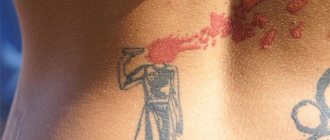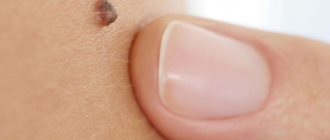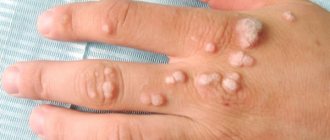Tattoo removal
Tattoos in Russia are becoming increasingly popular. Their durability is seen as an advantage by some and as a disadvantage by others. If over time you realize that the tattoo was a bad decision, or its execution leaves much to be desired, then you will need to undergo a series of professional tattoo removal procedures. However, not everyone is satisfied with the results of this treatment. Is it possible to permanently remove a tattoo?
Why remove tattoo
The number of people choosing to get a tattoo is increasing. Therefore, it is obvious that at the same time the number of those who want to remove it is growing. Many people are not satisfied with the appearance of a tattoo. Is the need for tattoo removal procedures increasing?
There can be many reasons why a person might want to do this. With the advent of tattoos, the problem of loss of skin elasticity and the appearance of wrinkles becomes more acute. Tattoos with names are most often removed. There are many cases where people remove tattoos due to problems finding a job.
Where are tattoos removed?
What should you do after you have decided to remove your tattoo?
Undoubtedly, it is worth visiting a doctor or cosmetologist. Only a professional assessment of the tattoo, the dyes used, and the depth of their introduction into the skin allows planning effective tattoo removal therapy.
However, you should not seek help from a tattoo parlor, since such premises are not equipped with modern equipment. Moreover, there is no expert who has experience in this type of surgery. The worst solution in this situation is to try to remove the tattoo yourself. Home tattoo removal methods do more harm than good, promoting the development of skin infections and scarring. Therefore, under no circumstances should you remove a tattoo at home.
Price
It is generally accepted that the price of laser correction is quite high. In many ways, this statement is true, but it should be remembered that costs to patients can vary greatly and depend on factors such as:
- Size of the treated area.
- The depth of penetration of the coloring composition, its type, and sometimes color.
- Type of laser used.
- Qualification of the specialist performing the manipulations.
| Price per 1 sq. cm | From 300 (total amount from 300) | From 250 (total amount from 1250) | From 200 (total amount from 2000) | From 100 – 150 (total amount from 3000) | From 80 – 100 (total amount from 4000) |
| Tattoo size (sq. cm) | 1 | 5 | 10 | 30 | 50 |
The price given in the table is indicative and determines the cost of one laser correction session. If it is necessary to carry out repeated work, a similar amount will have to be paid again.
Who is easier to remove tattoos?
Several factors influence the successful outcome of tattoo removal. Namely:
- age tattoo
- color of the skin
- tattoo color
- tattoo location
- the body's ability to regenerate
Naturally, the lighter the skin, the easier it will be to remove the tattoo. Especially if it is done on the arms, legs, chest or buttocks, and not much time has passed since it was applied. It is worth noting that monochromatic designs in black, red, purple and dark blue are subject to complete removal.
When not to remove a tattoo
There are also contraindications to tattoo removal. In fact, there are a lot of them, but the main list of cases when you should not remove a tattoo is as follows:
- skin disease
- any injuries at the tattoo site
- diseases of the cardiovascular system
- fresh tan
- epilepsy
- cancer
- pregnancy or lactation period
- blood disease
- diabetes mellitus in the decompensation phase
- infectious diseases
- taking medications that are photosensitizers
- thrombosis, varicose veins at the tattoo site
There are several types of tattoo removal:
- laser tattoo removal
- surgical intervention
- dermabrasion
- cover up
- coagulation method
- cryosurgical method
- chemical method
Contraindications to the procedure
The procedure has contraindications. There is a list of possible risks that the client is introduced to before signing consent for manipulation.
It is strictly forbidden to work with a laser if the following conditions exist:
- presence of hematomas on the body;
- development of an infectious disease;
- bleeding of any type;
- the presence of scars and cicatrices;
- presence of allergies;
- blood diseases;
- diseases associated with impaired brain activity;
- various skin diseases: eczema, acne.
Possible complications after the procedure:
- manifestation of hyperpigmentation of the skin;
- changes in skin structure, which may be temporary or permanent;
- darkening of the tattoo;
- change in shade, but not complete disappearance of pigment.
Laser tattoo removal
Which Tattoo Removal Procedure Works Best?
For many years, the most effective way to get rid of unwanted skin patterns has been laser tattoo removal.
Laser tattoo removal
The advantage of this method is exfoliation using dermabrasion or the use of chemical peels. This ensures the safety of the procedure. However, you should remember that laser treatment does not always guarantee your satisfaction with the procedure.
Does this mean that there is no 100% tattoo removal method?
No, this only means that the procedure must be performed using a modern laser, which has much greater capabilities than older generation lasers. Unfortunately, there are still few offices that can boast such an innovative laser.
Which dyes are the easiest to remove and which are considered the most problematic?
Dark colors are the easiest to remove. Reds and browns are removed quite well, while yellows and greens are a real problem. The white dye cannot be removed. The Alma Harmony Q switch emits wavelengths that allow the removal of a wide range of dyes. A beam with a length of 1064 nm is responsible for removing dark colors and 532 nm for bright colors. The ability to adjust the wavelength not only effectively reduces the amount of dyes entering the skin, but also minimizes the risk of scars or skin burns.
How is the laser tattoo removal procedure performed?
The laser removal procedure is very simple. The laser head is applied to the area of skin covered with the tattoo, and the incident beam causes the dye to break down. The ink is then removed and the tattoo gradually disappears. The duration of the procedure depends on the size of the tattoo. Thanks to the use of an anesthetic cream, the pain of the procedure is significantly reduced and the skin healing process goes smoothly.
To achieve a satisfactory effect, several procedures must be performed. Using the latest Q laser, laser tattoo removal is safe and effective.
Recovery period
Laser tattoo removal, which has numerous reviews, requires careful attention to the recovery period. In most cases, you can immediately return to normal life after the procedure.
But during the time when the skin is actively recovering, it is necessary to follow general recommendations:
- You cannot steam your skin for 14 days after the procedure;
- visiting baths, saunas or swimming pools is completely excluded;
- It is strictly forbidden to sunbathe or visit a solarium (such steps lead to injury and scarring).
If we are talking about removing a tattoo or tattoo on the face, then you should not use decorative cosmetics for several days in a row. For the body, avoid using alcohol-based products completely. It is also better to completely eliminate the possibility of exposing the treated area to hot water, rough clothing or synthetic dressings. It is necessary to avoid contact of injured skin with chemicals.
No special care is required for the removal area unless necessary. Experts recommend using a healing agent if the removal did not go as expected. You should not use special means to remove the resulting swelling. If everything is done correctly, the swelling will go away on its own in a few hours or a few days.
Surgical tattoo removal
Surgery to remove a tattoo is effective only when the tattoo is reduced to a small size. Using a dermatome device, a thin layer of skin that is saturated with paint is removed. There is another surgical method that has the opposite sequence - building up the dermis at the site of the tattoo. The process is long, but the most effective when removing a tattoo.
Consequences of surgical tattoo removal
It is worth knowing that after removing the pattern through surgery, a scar remains in this place. In addition, there is a risk of rejection of the extended skin, as well as the appearance of an inflammatory process. But despite these disadvantages, the most effective way to remove a small tattoo is through surgical tattoo removal.
Dermabrasion
Dermabrasion involves filing down areas of the skin with a diamond cutter in the area where the tattoo is located. Using this method, it is possible to get rid of shallow tattoos in just a few sessions.
Tattoo removed using dermabrasion
But there are many disadvantages - often there are scars and cicatrices when removing deep tattoos, long skin recovery and the pain of the procedure itself. In addition, there is a risk of skin discoloration.
Preparation for the procedure
Laser tattoo removal, reviews of which indicate its effectiveness, is a procedure that requires proper preparation. The quality and effectiveness of the result depends on compliance with the requirements.
Typical recommendations:
- For several weeks before visiting a specialist, it is recommended not to use sunscreen and avoid being in direct sunlight.
- You cannot depilate the part of the skin on which the tattoo is applied.
- Do not use exfoliating products, which include peelings and scrubs.
- Smoking is not recommended for several weeks before surgery.
- You should not take anti-inflammatory drugs or folk remedies that affect blood flow.
- A few hours before the procedure, you should drink as much water as possible.
It is impossible to completely remove a tattoo from the skin in one session. Complete discoloration can be achieved only after several sessions and restoration measures.
Coagulation method
Using this method, when removing a tattoo, the design is burned out with a high-frequency current. A wound forms on the skin, which then becomes covered with a dry crust and falls off. The big disadvantage of removing a tattoo in this way is that a scar in the shape of the removed tattoo remains in the burned area, and burns are also possible.
Coagulation method of tattoo removal
How to remove a tattoo with iodine?
- For the procedure, a 5% or 10% iodine solution is used. Depending on the area of the tattoo, it must be divided into sections. If the tattoo is small, this need disappears
- Iodine has a burning effect, so it is enough to apply it just once using a match and cotton wool to the surface of the skin.
- This procedure must be repeated throughout the day, three times. During this time, the skin begins to die and soften
Important: It is necessary for the skin to peel off without assistance. In case of intervention, the tattoo will begin to bleed and when iodine is subsequently applied, the surface of the skin will become very painful.
tattoo removal
- There is no need to protect the wound with bandages, since iodine has a disinfecting effect. At night, it is recommended to moisturize the area affected by iodine with ointment to restore the skin, which affects tissue metabolism
- The procedure for applying iodine must be carried out depending on the type of tattoo. In total, it takes from two weeks to two months
- Also, throughout the entire procedure and for two or three weeks after it, it is necessary to moisturize the skin with streptocide ointment or streptocide powder for effective healing
Important: Ultraviolet radiation has a very negative effect on damaged skin, so it is also recommended not to sunbathe during the procedure.
tattoo removal with iodine
Advice for tattoo lovers
It is worth saying that you are very thoughtful about the choice of tattoo and the place where it is applied. The choice of a tattoo artist is considered equally important. If you really need a tattoo, then thoroughly consider all the pros and cons, and only then go to the salon, where you will consult with a professional. Perhaps a tattoo artist will be able to dissuade you from getting a certain tattoo that you would like to get on some impulse, and then regret this moment. After all, tattoo removal is not a very pleasant procedure, and there is not always a good result when removing a tattoo.









